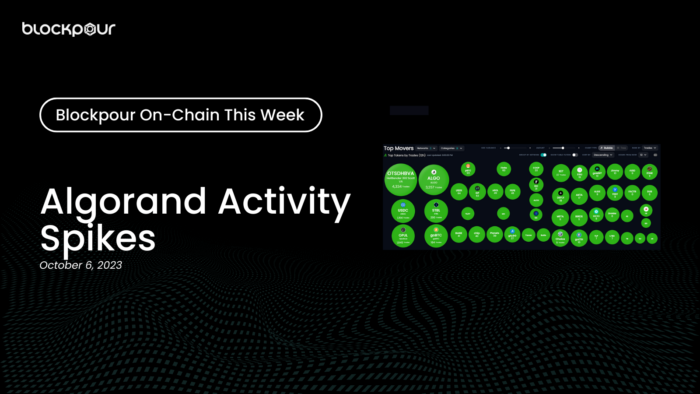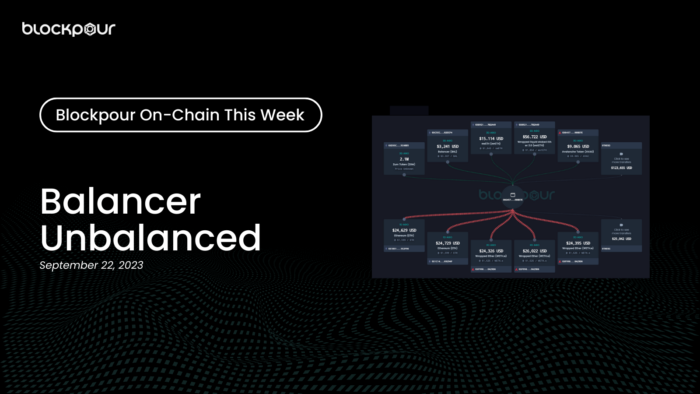Track ERC-20 token transfers with the upgraded Wallet Recon and Entity Flows tools
Table of Contents
Introduction
This Blockpour Basics article explains how to use the Wallet Recon and Entity Flows tools. These features data about how, when, and where labeled entities such as centralized exchanges (CEXes) and individual wallets or addresses are sending and receiving ERC-20 tokens. Traders, enterprises, and researchers can find immense value in this feature due to the highly customizable filtering and granularity of the data.
Blockpour 2.0 ushers in these new tools and others that make the platform far more powerful than ever before. The upgraded UI across the entire app improves every tool, both new and old. Other new tools like Top Movers add tremendous depth to research capabilities, as well. Read on to learn about the Wallet Recon and Entity Flows tools!
Use Wallet Recon and Entity Flows to find the data you need
Users can find these tools on the left-side menu on the new Blockpour 2.0 homepage at app.blockpour.com. Let’s start with Wallet Recon.
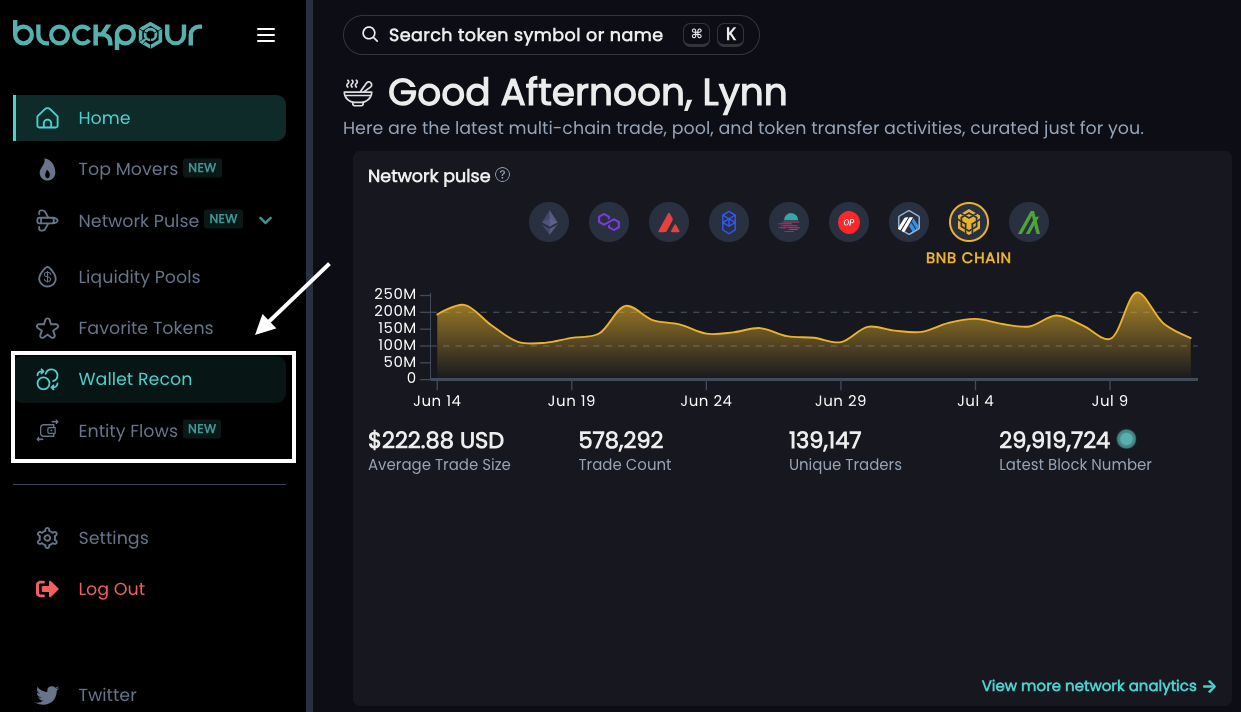
Where to find the Wallet Recon & Entity Flows on the left side menu.
Both the Wallet Recon and Entity Flows tools shows the ERC-20 token flows to and from entities such as:
- CEXes
- Centralized stablecoin issuers
- Wallets
- Smart contract addresses
Flows can be filtered in the following ways:
- Date range
- Entity / wallet or contract address
- Flow direction
- Specific tokens
- Most recent transfers
- Token amount
- Transfer value in USD

Filter date, entity, flows direction, token, and display options on Wallet Recon.
Inflows are transactions where tokens are sent to the chosen entity, whereas outflows are transactions where tokens are sent from the chosen entity. Users will find that inflows are displayed either vertically on the left side or horizontally on the top based on their preference, with a green string crawling from the transaction cards into the entity’s logo. Outflows are displayed either vertically on the right or horizontally on the bottom with a red string crawling from the entity’s logo into the transaction cards.
Use the filters on the top right to:
- Change the chart orientation
- Copy the search link
- Center the flow chart
- Show controls
- Exit the widget
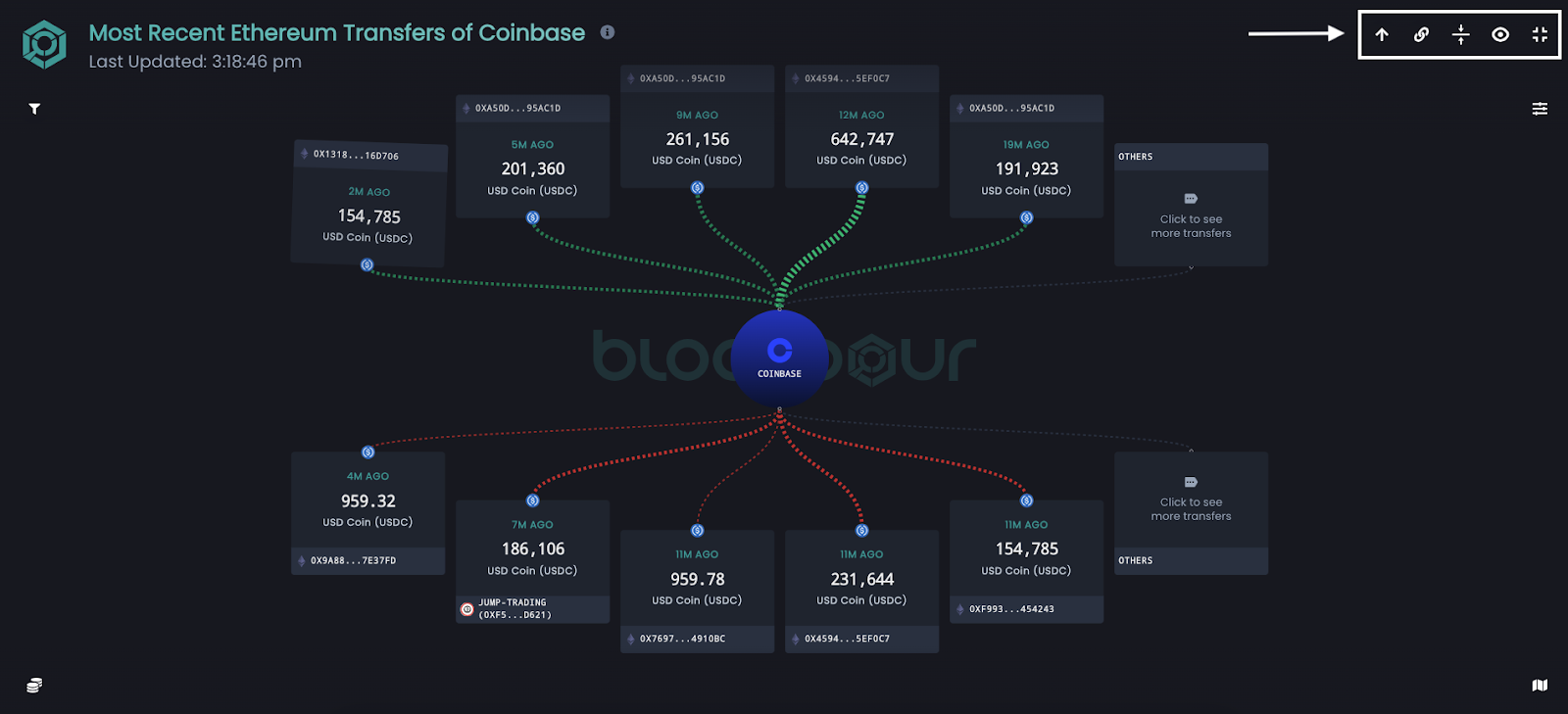
Find more filters at the top right of the page.
Click on the single standalone button on the top right to unfurl the slider menu. Use the slider to determine the amount of results a search shows and the spread between cards. There is a maximum of a combined 100 senders and receivers that can be displayed at one time.
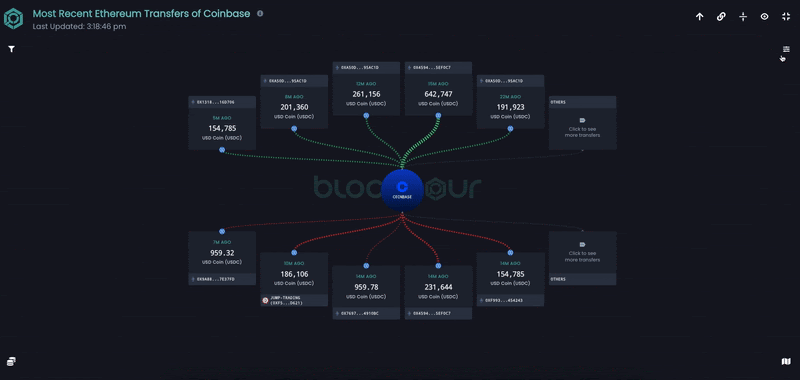
Filter the number of token flows to show on Wallet Recon.
Refine your search with more filters and data
The bottom right and bottom left corners provide additional functionality.
To quickly navigate to different cards, toggle through the minimap on the bottom right corner of the screen to show what other cards may be off-screen. Toggle between the number of tokens transferred and the USD value of transfers from the button on the button on the bottom left corner of the page.

Find more filters at the bottom left and right of the page on Wallet Recon.
Users can find detailed information about each transfer by clicking on a transfer card. For example, discover the Transfer ID, date, block number, and details of the sender and receiver of this $USDC transfer from Coinbase.
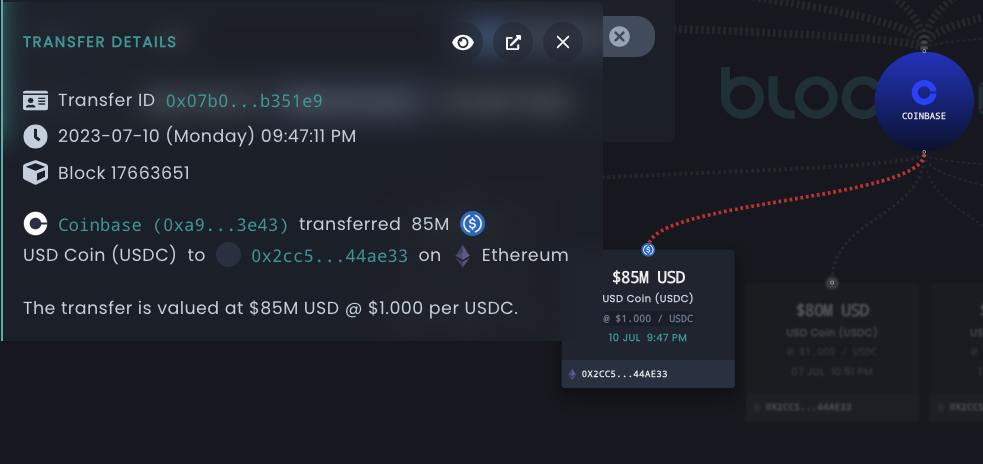
Find detailed transfer info about a transfer.
What to find on the new Entity Flows tool
Although both the Wallet Recon and Entity Flows tools are powered by the Blockpour API, and both tools display token transfer data, they display that data in different ways.
Like with Wallet Recon, searches on Entity Flows are filtered by one entity at a time by date range, but there are no token-specific searches. Entity Flows shares other unique data from the Blockpour API that is not found on Wallet Recon.
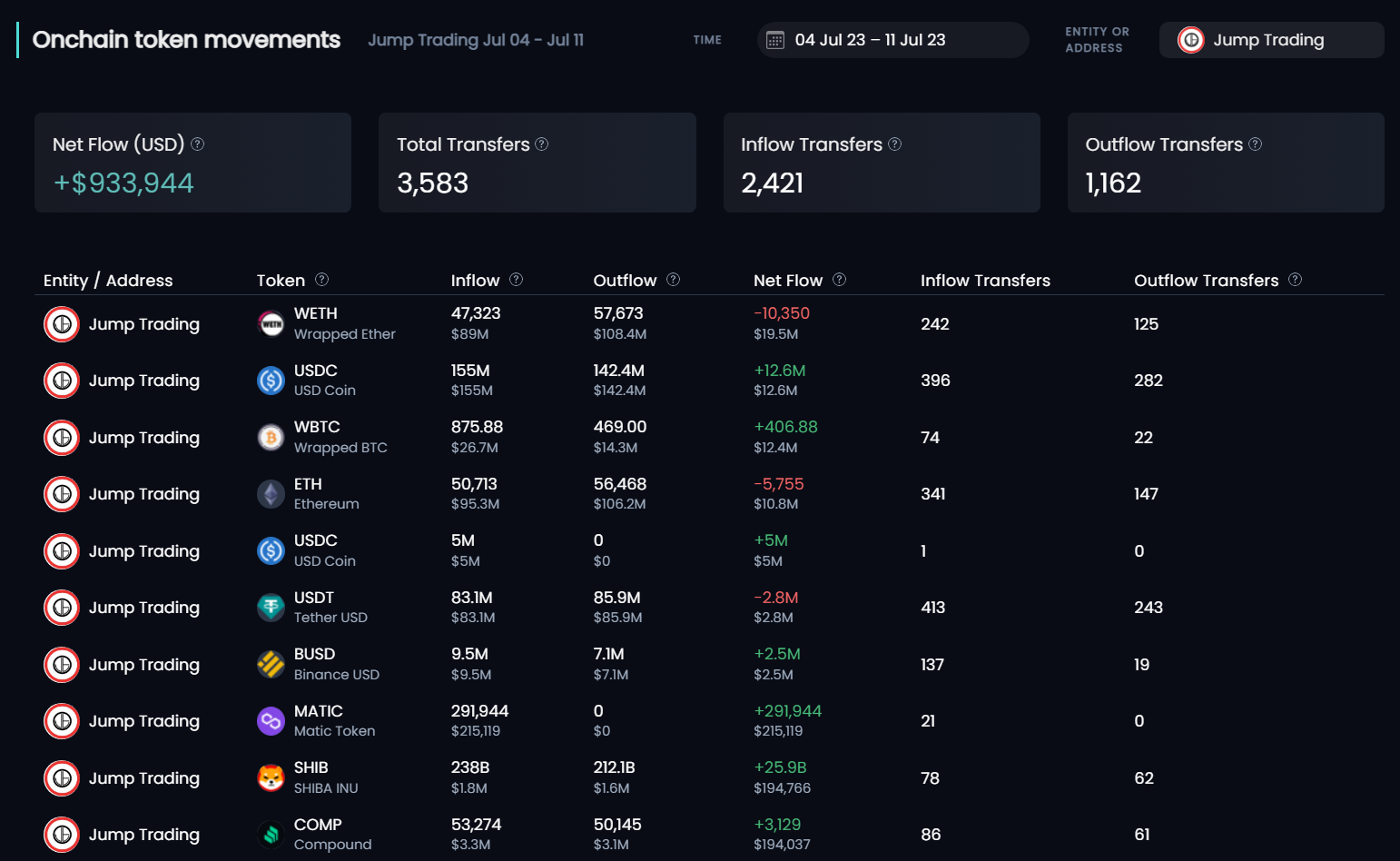
The Entity Flows results page.
Users will first find the date and entity filters at the top right of the Entity Flows page. Like on Wallet Recon, users can search either the Blockpour labeled entities or enter the ERC-20 wallet address of their choice. Just below that, from the left, data on the net flows in USD value, total transfers in and out of the entity, number of inflows, and number of outflows are displayed within the specified date range.

Find on-chain token movements about an entity.
Below the data table defaults to show the highest net flows in USD at the top. However, the table can be filtered to display results in ascending or descending order by any of the categories on the table.
From left, the categories of data on the table are:
- Entity / Address
- Token
- Inflow
- Outflow
- Net Flows
- Inflow Transfers
- Outflow Transfers
The Entity / Address column cannot be re-sorted. The Token column can be sorted alphabetically. The remaining columns can be re-sorted by size in ascending or descending order.
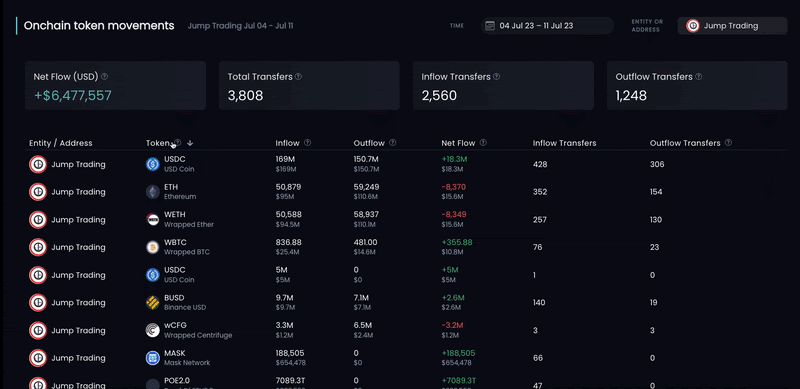
Where’s the Alpha?
The broad functionality of the Wallet Recon and Entity Flows tools opens the door to many different use cases for a wide variety of users.
Traders can monitor wallets of specific traders or entities to discover what these addresses are buying, holding or selling. More importantly, traders can see where and when tokens are being moved for specified time-ranges as well transfers occurring in real-time. Watching flows of top CEXes can be a major indicator of how the market may move on a macro scale or for a specific token.
These tools allow users to monitor how well-capitalized entities such as whales or venture capital firms are allocating their funds beginning from the moment they withdraw from a CEX.
Furthermore, dApps and other data-oriented operations can use the visualizations to discover the journey their users take within their apps or protocols — including what users do with assets before and after interacting with the protocol.
Lastly, users can perform on-chain analysis of ERC-20 tokens movements across the ecosystem, which can help form trading strategies or provide indications that the next move in a strategy should be made.
Conclusion
Blockpour’s Wallet Recon and Entity Flows tools help users seamlessly navigate through complicated crypto data in a way unique to the ecosystem. To find alpha with Wallet Recon, Entity Flows, and any of our other new and upgraded tools such as Network Pulse, visit blockpour.com today.
About Blockpour
Blockpour is a technology firm specializing in Web3 data and analytics, offering individuals and businesses indispensable data and tools to navigate the dynamic on-chain universe while bridging seamlessly to the off-chain world.
Through our real-time and historical multi-chain data feeds, businesses and traders can fully unlock the power of blockchain data to inform their strategies, optimize operational efficiency, and drive top-line growth.
To learn more about Blockpour check out our website and follow us on Twitter or LinkedIn. For sales or inquiries about the API, contact [email protected].
Disclaimer:
The above article is for informational purposes only and is not financial advice. Blockpour is a data aggregation and analytics platform only and does not provide financial advice or services of any kind.
